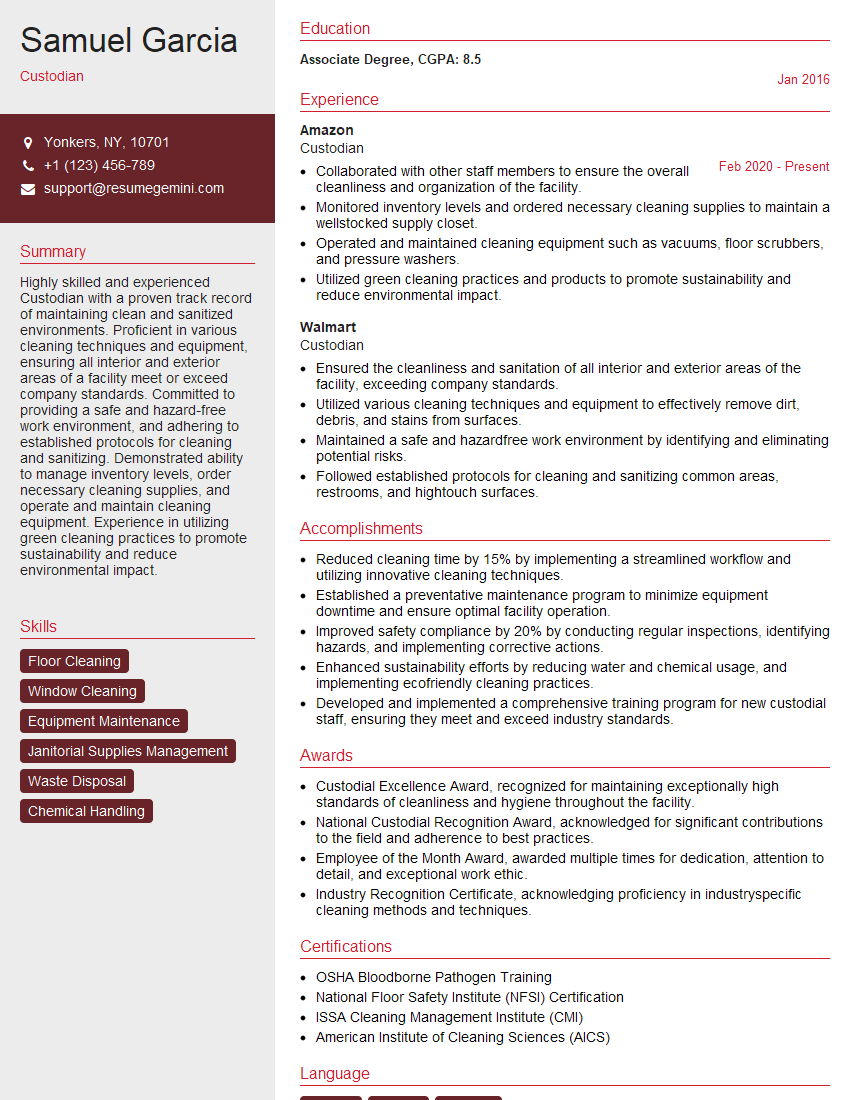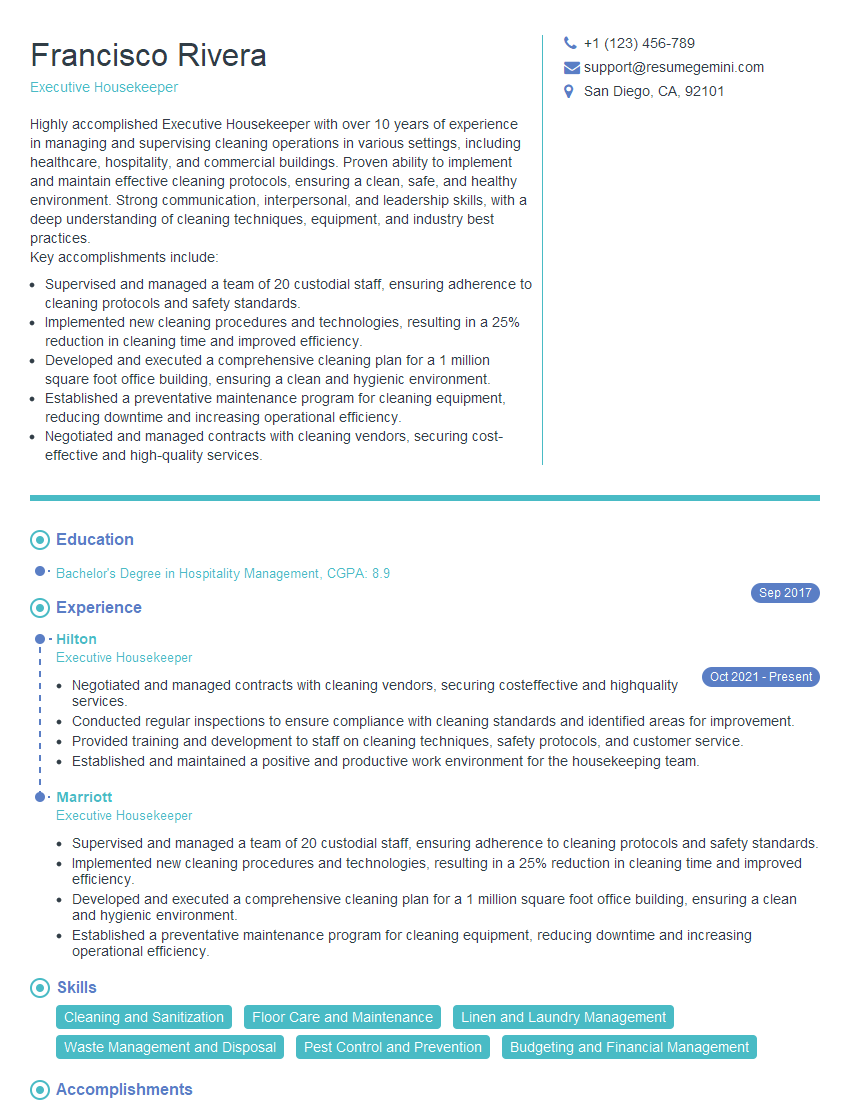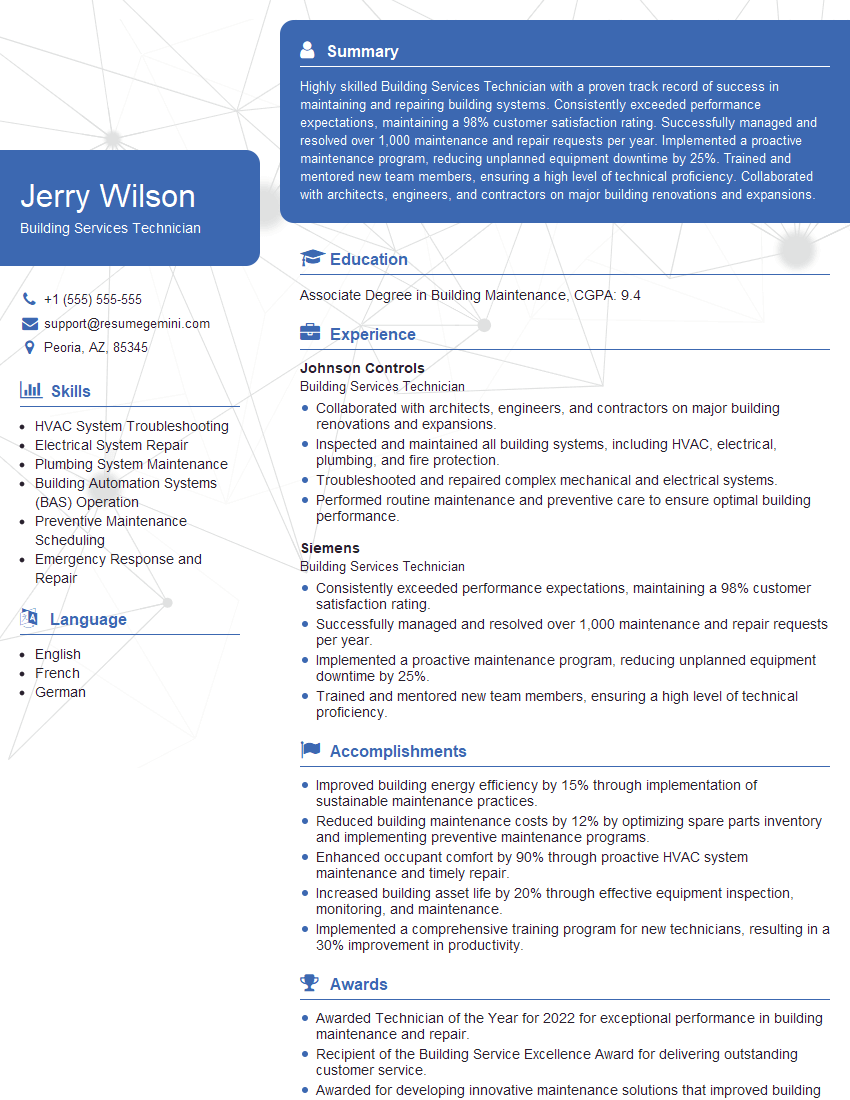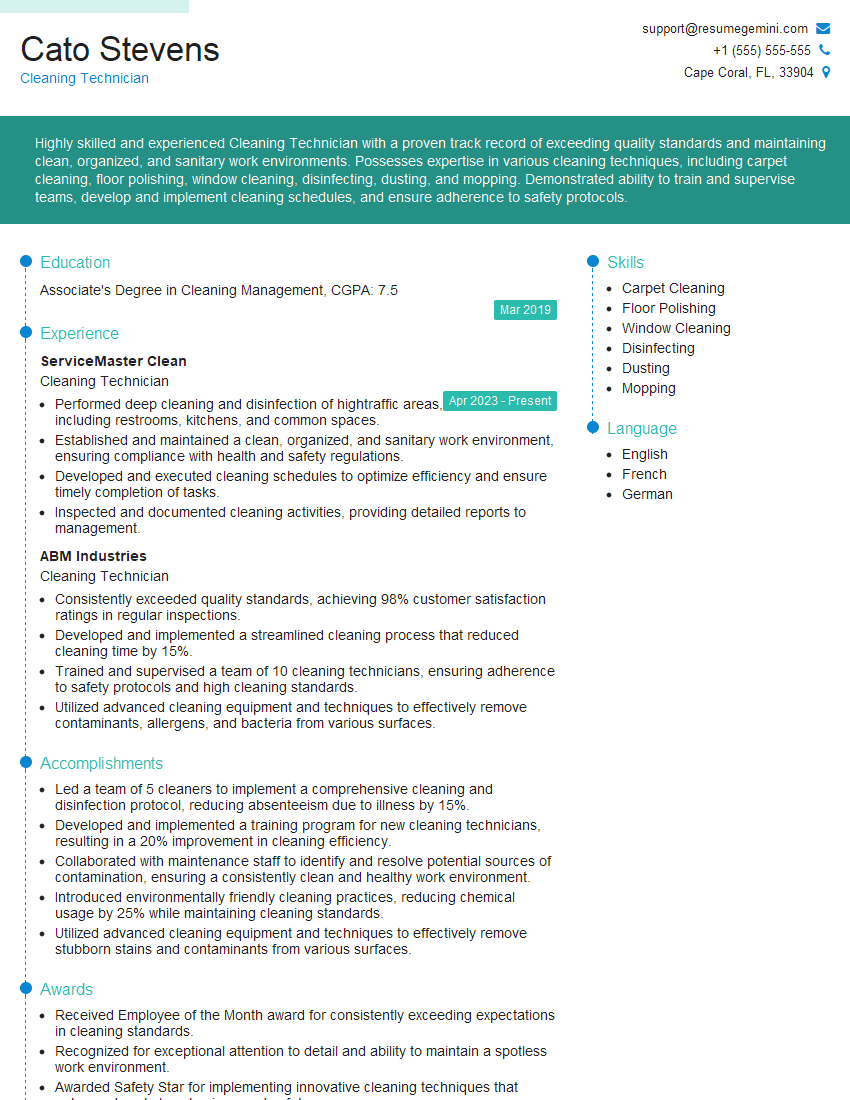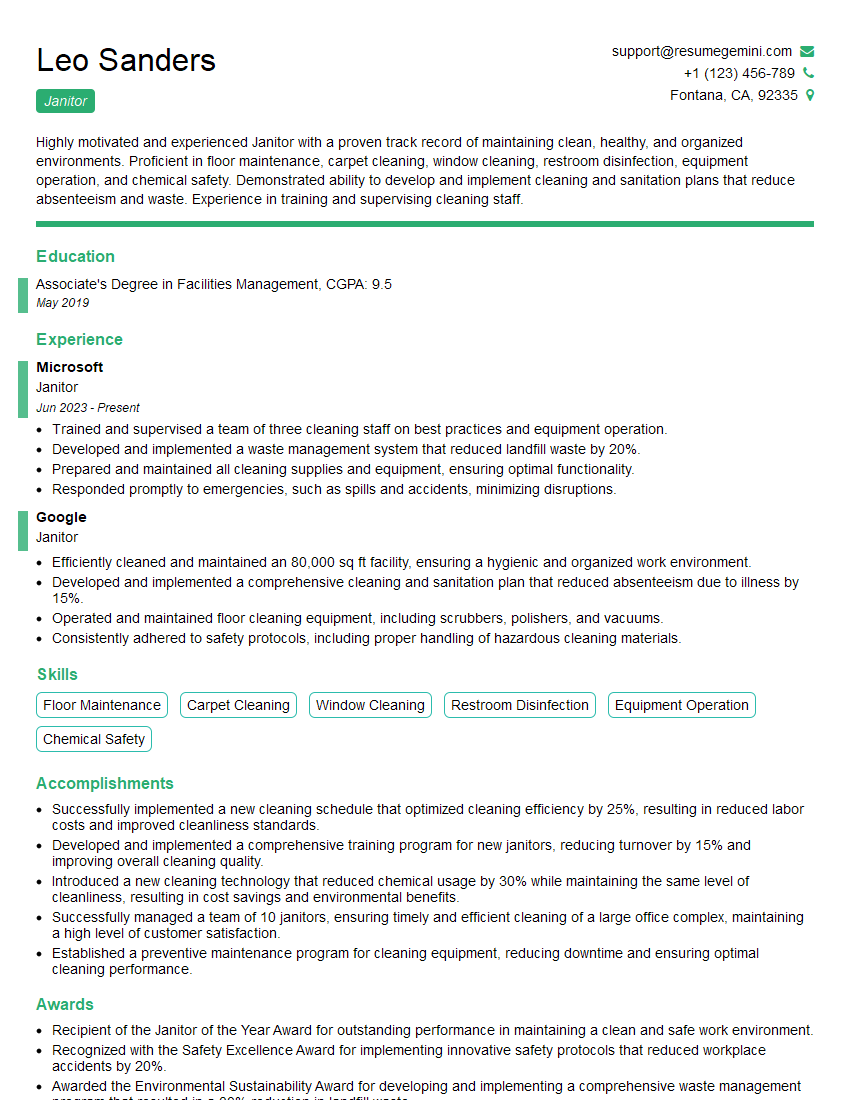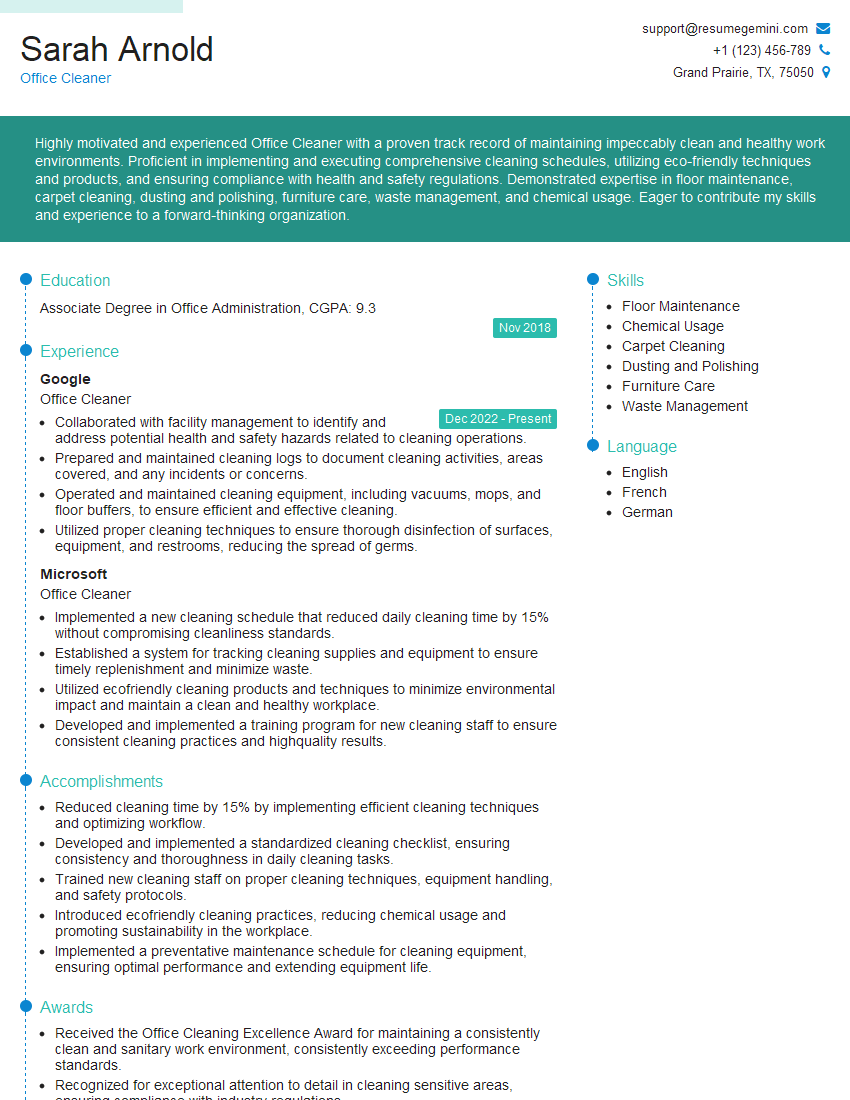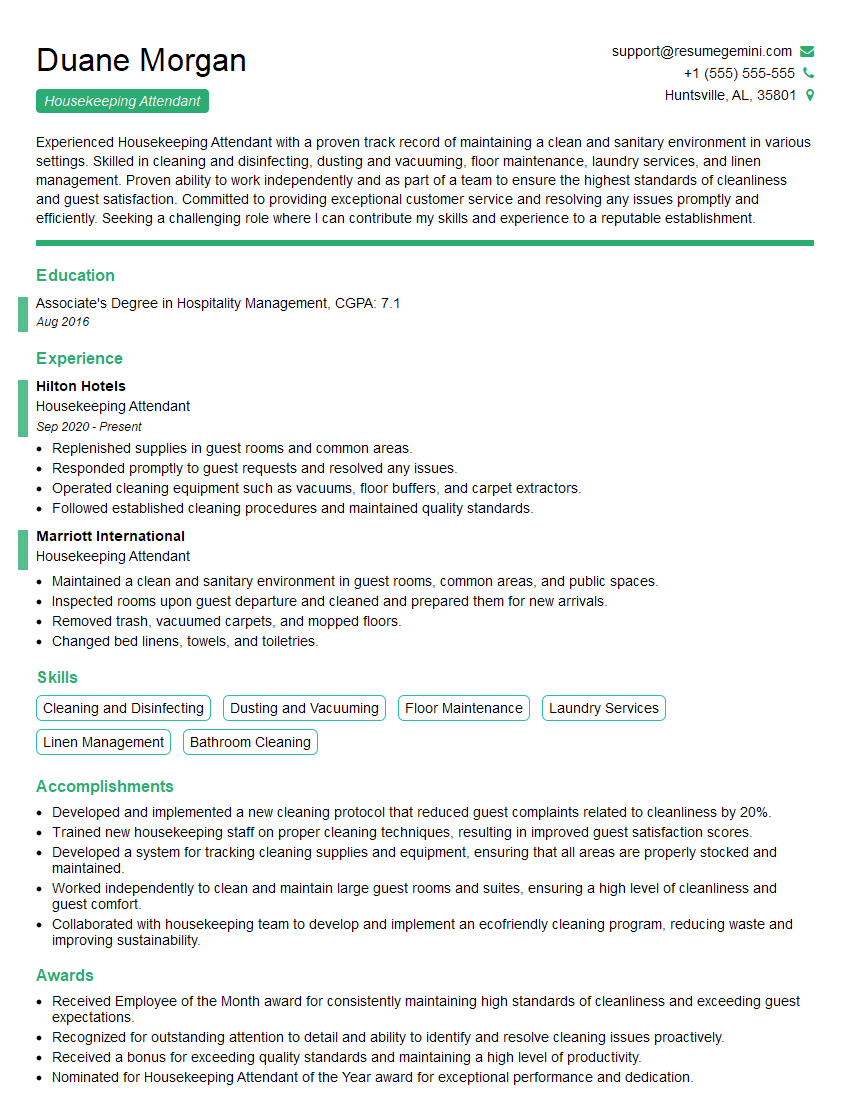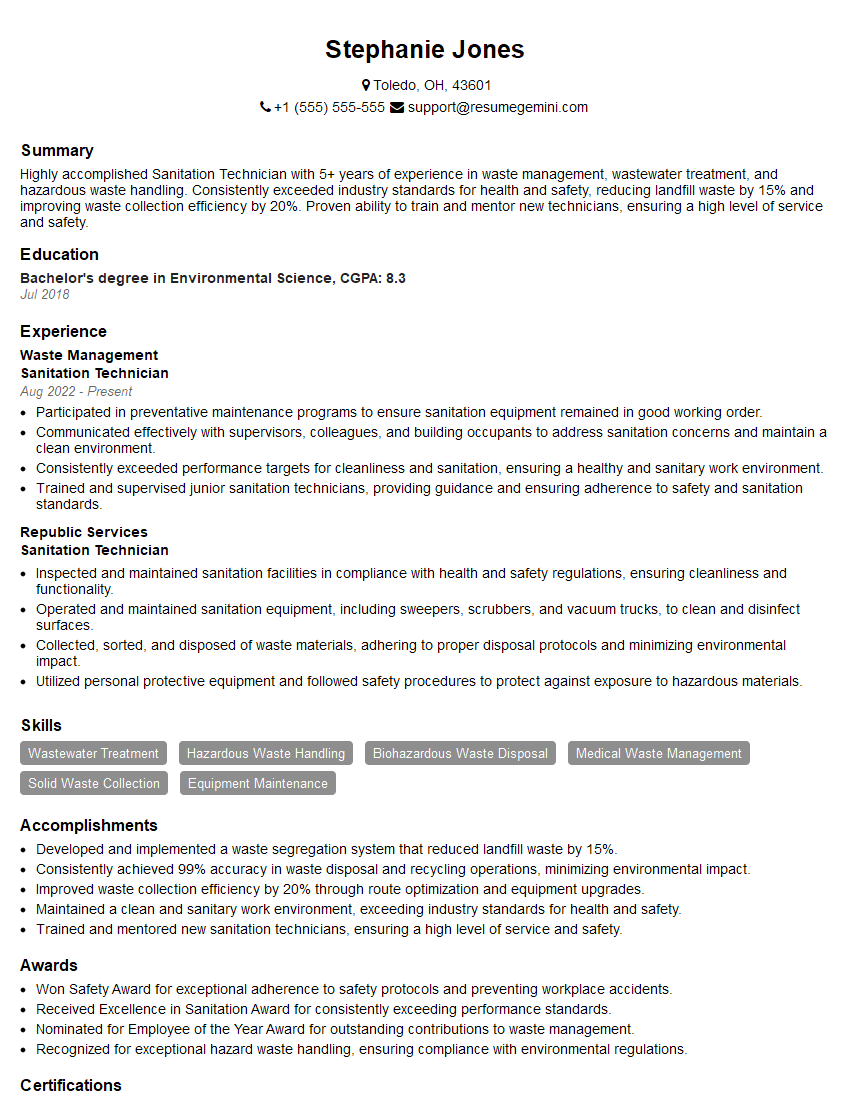Interviews are more than just a Q&A session—they’re a chance to prove your worth. This blog dives into essential Office Cleaning interview questions and expert tips to help you align your answers with what hiring managers are looking for. Start preparing to shine!
Questions Asked in Office Cleaning Interview
Q 1. Describe your experience with various cleaning equipment (e.g., vacuum cleaners, floor buffers, carpet extractors).
My experience encompasses a wide range of cleaning equipment, from basic vacuum cleaners to specialized machinery. I’m proficient with both upright and canister vacuums, understanding the nuances of different suction powers and brush roll types for various floor coverings. For example, I use a powerful upright vacuum with a HEPA filter for carpeted areas to effectively remove dust mites and allergens, while a lightweight canister vacuum is ideal for reaching tight spaces and delicate surfaces like hardwood floors. I’m also experienced with floor buffers, utilizing both high-speed and low-speed options depending on the floor type and the need for polishing or scrubbing. My experience extends to carpet extractors, which are essential for deep cleaning carpets and removing stubborn stains. I understand the importance of using the correct cleaning solution and the proper drying techniques to prevent mold and mildew growth. I’m familiar with the maintenance required for each piece of equipment, ensuring its longevity and optimal performance.
Furthermore, I’m comfortable operating other cleaning equipment like steam cleaners for sanitizing hard surfaces and window cleaning systems for efficient streak-free cleaning.
Q 2. What cleaning agents are you familiar with and how do you select the appropriate one for different surfaces?
I’m familiar with a variety of cleaning agents, including all-purpose cleaners, disinfectants, glass cleaners, floor cleaners (specifically formulated for different floor types like hardwood, tile, and carpet), and specialized stain removers. Selecting the appropriate cleaning agent is crucial to avoid damaging surfaces and ensure effective cleaning. For example, I would never use an abrasive cleaner on a polished marble countertop, instead opting for a pH-neutral cleaner. Similarly, a strong disinfectant is necessary in restrooms, while a gentler cleaner is better suited for sensitive electronics. My selection process always starts with identifying the surface material and the type of soil or stain present. I carefully read product labels to ensure compatibility and follow manufacturer instructions for dilution and application.
I understand the importance of using environmentally friendly products whenever possible, minimizing the impact on the environment and the health of building occupants.
Q 3. Explain your understanding of workplace safety regulations related to cleaning.
Workplace safety is paramount. My understanding of cleaning safety regulations includes proper handling and storage of chemicals, the use of personal protective equipment (PPE) such as gloves, eye protection, and respirators when handling hazardous substances, and the correct procedures for handling spills and sharps. I’m aware of the importance of proper ventilation to prevent inhaling harmful fumes and the necessity of following the Material Safety Data Sheets (MSDS) for all cleaning products. I also understand the importance of safe practices like using appropriate warning signs, proper disposal of waste, and maintaining a clean and organized workspace to prevent slips, trips, and falls. I am always mindful of emergency procedures and know how to contact emergency services if needed.
Regular training on safety protocols is essential, and I actively seek opportunities to update my knowledge on best practices.
Q 4. How do you prioritize cleaning tasks in a busy office environment?
Prioritizing tasks in a busy office environment requires a systematic approach. I typically start by assessing high-traffic areas, such as entrances, restrooms, and common areas, which require more frequent cleaning. I then prioritize tasks based on urgency and impact. For instance, cleaning up a spill immediately is more important than dusting shelves. I often follow a checklist to ensure consistency and completeness. My approach involves focusing on high-impact tasks first, then moving towards lower-impact tasks. I also take into account the time constraints and adjust my priorities accordingly. This might involve focusing on high-traffic areas early in the morning to prepare for the start of the workday, and addressing other areas later in the day. Effective time management and efficient cleaning techniques are key to successfully handling a busy workload.
Q 5. Describe your experience with maintaining restrooms and ensuring hygiene standards.
Maintaining restrooms and ensuring hygiene standards requires meticulous attention to detail. My routine includes regular cleaning and disinfection of toilets, sinks, and countertops, using appropriate disinfectants to kill germs and bacteria. I replenish soap, paper towels, and toilet paper as needed and empty waste receptacles frequently. I carefully inspect for any leaks, clogs, or other maintenance issues and report them immediately. I pay close attention to high-touch surfaces like door handles and faucet handles, ensuring thorough disinfection. Regular cleaning, coupled with proper ventilation, helps maintain a hygienic and pleasant restroom environment. I always aim to leave the restrooms clean, well-stocked, and free of unpleasant odors.
Q 6. How do you handle spills and other unexpected cleaning emergencies?
Handling spills and unexpected cleaning emergencies requires quick thinking and decisive action. My first step is always to assess the situation and ensure my safety, using appropriate PPE if necessary. Then, I take steps to contain the spill, preventing it from spreading. For example, if it’s a liquid spill, I’ll absorb it using absorbent materials like paper towels or spill kits. For hazardous materials, I’ll follow the specific cleanup instructions provided on the MSDS. After containing the spill, I’ll thoroughly clean and disinfect the affected area to prevent any hazards. Proper documentation of the incident, including the type of spill and the steps taken to clean it, is also important for maintaining records and identifying potential hazards.
Q 7. How do you ensure the proper disposal of cleaning supplies and waste?
Proper disposal of cleaning supplies and waste is crucial for environmental protection and workplace safety. I strictly adhere to all local and company regulations for waste disposal. Cleaning solutions are disposed of according to their specific instructions on the label, often involving dilution before disposal down the drain or separate collection for hazardous waste. I use designated containers for different types of waste, such as sharps containers for used needles or blades, and separate bins for recyclable and non-recyclable materials. All waste is labeled correctly to ensure proper handling and disposal by waste management personnel. Regular cleaning and maintaining cleanliness in the storage areas of cleaning supplies helps maintain order and prevents accidents.
Q 8. What is your experience with carpet cleaning techniques?
Carpet cleaning requires a multifaceted approach, going beyond simple vacuuming. My experience encompasses various techniques, selecting the best method based on the carpet type, soiling level, and client preferences.
Hot water extraction (steam cleaning): This is a highly effective method for deep cleaning, using hot water and detergent to loosen dirt and then extracting the solution. I always pre-test the cleaning solution in an inconspicuous area to prevent damage or discoloration. For instance, in a recent office clean, I successfully removed a stubborn red wine stain from a wool carpet using this method, carefully following the manufacturer’s guidelines.
Dry cleaning: This method uses absorbent powders or compounds to lift dirt and grime, suitable for delicate carpets or areas where water damage is a concern. I’ve found this particularly useful in offices with high-traffic areas where downtime needs to be minimized. The quick drying time allows for minimal disruption.
Encapsulation cleaning: This technique employs crystallizing cleaning solutions that encapsulate soil particles, allowing them to be easily vacuumed away. It’s a low-moisture method ideal for maintaining carpets between deep cleans.
Beyond the technique itself, I prioritize thorough pre-vacuuming to remove loose debris and post-cleaning grooming to restore the carpet’s pile and texture. Proper drying is crucial to prevent mold and mildew growth, and I always ensure adequate ventilation.
Q 9. Describe your experience with window and glass cleaning methods.
Window and glass cleaning requires precision and the right tools. My experience includes both interior and exterior cleaning, utilizing different methods based on the surface and its condition.
Traditional method: Using a squeegee and microfiber cloths is my preferred technique for most windows. The right technique involves overlapping strokes to avoid streaks. I always clean from top to bottom to prevent drips. I also use distilled water to minimize water spots, particularly noticeable on large windows.
Specialized cleaning solutions: I use professional-grade cleaning solutions tailored for different types of glass, ensuring effective cleaning without damage. I meticulously avoid harsh chemicals that could damage window frames or seals.
High-reach pole systems: For hard-to-reach windows, I use telescopic poles with attachable squeegees and brushes. This allows safe and efficient cleaning of high windows, eliminating the need for ladders in most instances. Safety is my top priority.
Regardless of the method, I always ensure a thorough inspection after cleaning, paying close attention to details such as corners and edges. A streak-free, sparkling finish is my goal.
Q 10. How do you organize your workload efficiently?
Efficient workload organization is key to delivering exceptional cleaning services. I use a systematic approach:
Detailed walkthrough: Before starting, I perform a thorough walkthrough to assess the scope of work, identifying specific areas needing attention.
Prioritization: I prioritize tasks based on urgency and importance, focusing on high-traffic areas and high-touch surfaces first. For instance, restrooms and common areas are tackled early to prevent further contamination.
Task scheduling: I create a detailed schedule that breaks down the cleaning process into manageable blocks of time. This ensures a consistent pace and prevents time wastage.
Teamwork (if applicable): When working with a team, clear communication and task delegation are crucial. We assign tasks based on individual strengths and expertise.
Regularly reviewing and adjusting the schedule allows for flexibility and adaptability to unexpected events or changing priorities. This organized approach maximizes efficiency and ensures consistent quality.
Q 11. How do you maintain a consistently high level of cleanliness?
Maintaining a consistently high level of cleanliness requires attention to detail and a commitment to established procedures.
Standard Operating Procedures (SOPs): I adhere to standardized cleaning protocols for each task, ensuring consistency in the quality of cleaning across all areas.
Quality checks: Regular quality checks are performed throughout the cleaning process, allowing for immediate correction of any issues.
Regular equipment maintenance: Clean and well-maintained equipment is essential for effective cleaning. I regularly inspect and maintain cleaning tools and machinery.
Continuous improvement: I constantly look for opportunities to improve efficiency and the effectiveness of cleaning methods. This includes staying updated on new cleaning technologies and best practices. For example, I recently implemented a new microfiber cloth system that dramatically reduced cleaning time while enhancing results.
Consistent application of these strategies allows me to meet and exceed client expectations, building trust and ensuring client satisfaction.
Q 12. Explain your method for handling hazardous waste.
Safe handling of hazardous waste is paramount. My approach follows strict safety regulations and company protocols.
Proper labeling and segregation: Hazardous materials, like cleaning chemicals, are clearly labeled and stored separately from other waste. I use designated containers for each type of hazardous waste.
Personal Protective Equipment (PPE): I always wear appropriate PPE, including gloves, eye protection, and sometimes respirators, depending on the chemical involved. Safety is non-negotiable.
Disposal according to regulations: I strictly adhere to local regulations for the disposal of hazardous waste, ensuring its proper handling by licensed waste disposal companies. I meticulously maintain records of all waste disposal activities.
Emergency preparedness: I’m familiar with emergency procedures in case of spills or accidents, and know how to respond appropriately and safely.
Careful adherence to these procedures ensures both the safety of myself and others, and compliance with environmental regulations.
Q 13. Describe your experience with disinfecting high-touch surfaces.
Disinfecting high-touch surfaces is a crucial aspect of maintaining a hygienic office environment. My method focuses on thorough cleaning followed by effective disinfection.
Thorough cleaning: Before disinfection, I always thoroughly clean the surface to remove visible dirt and debris. This ensures the disinfectant can effectively reach the pathogens.
EPA-registered disinfectants: I use EPA-registered disinfectants effective against a broad spectrum of viruses and bacteria. I carefully follow the manufacturer’s instructions regarding contact time and application method. For example, I use different disinfectants for bathrooms than for general office areas, depending on the potential pathogens.
Focus on high-touch areas: I pay particular attention to frequently touched surfaces such as doorknobs, light switches, keyboards, and countertops. These areas are often breeding grounds for germs.
Proper ventilation: Adequate ventilation is crucial, especially when using strong disinfectants. I ensure proper air circulation during and after the disinfection process.
My goal is not only to clean but to actively create a sanitary environment that minimizes the risk of infection.
Q 14. How do you manage time effectively to meet deadlines?
Effective time management is essential for meeting deadlines and providing quality service. I employ several strategies:
Realistic scheduling: I develop realistic schedules that account for potential delays and unforeseen circumstances. I avoid overbooking and allow for buffer time.
Prioritization and task delegation: I prioritize tasks based on urgency and importance. If working as part of a team, I effectively delegate tasks to optimize time use.
Efficient work techniques: I use efficient cleaning methods and tools to maximize productivity. For example, using a caddy to carry cleaning supplies minimizes trips back and forth.
Regular progress checks: I regularly monitor my progress against the schedule to identify any potential issues early on. This allows for proactive adjustments.
Communication: Open communication with clients is essential to manage expectations and address any unforeseen delays. Proactive communication builds trust and enhances client satisfaction.
By proactively managing time and adapting to changing needs, I ensure consistent and timely completion of cleaning tasks.
Q 15. How do you ensure the confidentiality of client information while performing your duties?
Client confidentiality is paramount in office cleaning. We treat all information encountered during our work – from schedules and access codes to the contents of waste bins – with the utmost discretion. We never discuss client matters outside of the work environment, and we adhere strictly to non-disclosure agreements if required. Think of it like a doctor-patient relationship: what we see and hear in the office stays in the office.
For example, if I find sensitive documents while emptying a trash can, I immediately seal them securely and inform my supervisor. We follow strict protocols for handling such situations, ensuring the client’s information is protected at all times.
Career Expert Tips:
- Ace those interviews! Prepare effectively by reviewing the Top 50 Most Common Interview Questions on ResumeGemini.
- Navigate your job search with confidence! Explore a wide range of Career Tips on ResumeGemini. Learn about common challenges and recommendations to overcome them.
- Craft the perfect resume! Master the Art of Resume Writing with ResumeGemini’s guide. Showcase your unique qualifications and achievements effectively.
- Don’t miss out on holiday savings! Build your dream resume with ResumeGemini’s ATS optimized templates.
Q 16. Describe your experience working in a team environment.
I thrive in team environments. In my previous role, we had a team of five, and effective teamwork was key to maintaining a high standard of cleanliness across multiple large offices. We assigned tasks based on individual strengths and efficiently covered for each other during absences or unexpected challenges. For example, if one team member was running behind schedule on one task, others would adjust their workflow to support and maintain our collective deadlines. This required clear communication and mutual respect, which we cultivated through regular team meetings and informal check-ins.
We developed a system where we could visually track our progress and identify areas needing extra attention, leading to a more efficient and cohesive cleaning operation. This collaboration not only streamlined our work but also fostered a positive and supportive work atmosphere.
Q 17. How do you adapt to changing priorities and schedules?
Adaptability is crucial in office cleaning. Priorities often change unexpectedly – a last-minute client request, an urgent spill cleanup, or a sudden equipment malfunction. I approach these situations calmly and systematically, prioritizing tasks based on urgency and impact. I utilize time management techniques such as prioritization matrices to ensure urgent tasks are tackled first while maintaining a balance across all duties. This helps to prevent any disruption to the scheduled cleaning routine or client satisfaction.
For example, if a client requests an emergency deep clean of a specific area, I will adjust the daily schedule, delegating other less-urgent tasks to other team members if necessary, and focusing my immediate efforts on addressing the client’s urgent need. Communication with both the team and the client is vital in ensuring a smooth adjustment.
Q 18. How do you deal with challenging or difficult situations?
Challenging situations arise, such as dealing with difficult equipment malfunctions or unforeseen messes. My approach is always calm and problem-solving oriented. I systematically assess the situation, identifying the root cause and developing a solution. If I encounter a problem beyond my expertise, I immediately seek assistance from my supervisor or more experienced team members. Open communication is crucial in these situations – both with colleagues and clients.
For example, if a floor buffer malfunctions, I wouldn’t panic. Instead, I’d carefully assess the damage, determine whether I can temporarily fix it, and promptly notify my supervisor to arrange for repair or replacement. Maintaining a proactive and solutions-focused attitude is key to navigating these challenges efficiently and effectively.
Q 19. How do you handle customer complaints or feedback?
Client feedback is invaluable. I approach complaints with empathy and a willingness to understand the client’s perspective. I actively listen, acknowledge their concerns, and apologize if appropriate. Then, I work collaboratively with the client to find a mutually agreeable resolution. This might involve re-cleaning an area, adjusting a cleaning procedure, or simply explaining the rationale behind a certain approach.
I document all complaints and resolutions meticulously, which helps to improve our services and address recurring issues. Even positive feedback is carefully reviewed to identify areas of strength and potential for improvement, allowing continuous refinement of our cleaning processes and client service.
Q 20. Explain your experience with using cleaning checklists and schedules.
Checklists and schedules are the backbone of efficient and consistent office cleaning. I have extensive experience using both digital and paper-based systems. Checklists ensure that all tasks are completed thoroughly and consistently, while schedules help to optimize workflow and resource allocation across multiple offices or work areas. I find that a combination of both offers the best outcome – technology for tracking progress and paper for detailed tasks where internet access might be limited.
For instance, a digital checklist might track progress on larger tasks, while a paper checklist can be carried room-to-room to meticulously track the completion of individual tasks in each space (e.g., dusting, vacuuming, emptying trash cans). This layered approach helps ensure comprehensive and consistent service.
Q 21. Describe your experience with different floor types (e.g., tile, carpet, hardwood).
I’m proficient in cleaning various floor types, each requiring a tailored approach. Tile floors need specific cleaning solutions to prevent streaking and maintain shine. Carpet requires appropriate vacuuming techniques and occasional deep cleaning to remove stains and allergens. Hardwood floors necessitate gentler cleaning methods to avoid scratching and damage. My experience includes using various cleaning equipment, such as buffer machines, carpet extractors, and specialized cleaning solutions for each type of floor.
For example, when cleaning hardwood floors, I would use a pH-neutral cleaner and a microfiber mop to prevent damage. Carpet cleaning requires the careful selection of cleaning solutions to avoid staining, and appropriate vacuuming technique to avoid matting of fibers. This ensures a high level of cleanliness while preserving the integrity and lifespan of each surface.
Q 22. How do you prevent the spread of germs and infections?
Preventing the spread of germs and infections in office cleaning is paramount. It’s not just about making things look clean; it’s about creating a truly healthy environment. My approach is multi-faceted and focuses on meticulous cleaning procedures and the use of appropriate disinfectants.
Regular Disinfection: I prioritize disinfecting high-touch surfaces like doorknobs, light switches, keyboards, and shared equipment. I use EPA-registered disinfectants following the manufacturer’s instructions carefully, ensuring sufficient contact time for effective germ elimination. For example, in a shared office kitchen, I would thoroughly disinfect the microwave handles, coffee machine buttons, and sink faucets daily.
Proper Cleaning Techniques: I use a systematic approach, starting with dry dusting to remove loose debris and then wet cleaning to remove dirt and grime. This prevents the spread of germs through the air. I change cleaning cloths frequently to avoid recontamination. Imagine cleaning a desk – I would dust it first, then use a clean cloth dampened with disinfectant to wipe down the entire surface.
Hand Hygiene: This is crucial! I wash my hands thoroughly and frequently with soap and water, especially after handling potentially contaminated surfaces. I always use hand sanitizer between cleaning different areas. This simple act prevents cross-contamination significantly.
Waste Disposal: Proper waste disposal is key. I always use appropriate waste bags and containers, separating hazardous waste (like broken glass) and disposing of them according to company policy and safety regulations.
Q 23. What are your skills in using specialized cleaning equipment such as pressure washers?
I’m proficient in using a range of specialized cleaning equipment, including pressure washers. My experience includes operating both cold and hot water pressure washers, understanding their different applications and limitations. I’m familiar with safety protocols, including wearing appropriate protective gear like safety goggles and gloves.
For instance, I’ve used pressure washers effectively to clean exterior walkways, removing ingrained dirt and grime, and have also used them for more delicate tasks, such as cleaning exterior window frames, adjusting the pressure accordingly to prevent damage. I always inspect the area before cleaning to identify any potential hazards and to select the appropriate nozzle and pressure setting.
Beyond pressure washers, I’m also skilled in using other specialized equipment, including floor scrubbers, carpet extractors, and various types of vacuum cleaners, selecting the most appropriate tool for the specific cleaning task at hand.
Q 24. What is your understanding of green cleaning practices?
Green cleaning is a practice I strongly support. It involves using cleaning methods and products that are environmentally responsible and promote a healthier indoor environment. This means minimizing the use of harsh chemicals and prioritizing sustainable practices.
Eco-Friendly Products: I’m trained to use and select cleaning products with minimal volatile organic compounds (VOCs), biodegradable formulas, and sustainable packaging. These products are less harmful to people and the environment.
Water Conservation: I employ techniques to conserve water, such as using microfiber cloths that require less water for effective cleaning and ensuring that cleaning solutions are properly diluted and utilized efficiently.
Waste Reduction: I’m committed to reducing waste by reusing cleaning cloths whenever possible, properly sorting and recycling waste, and using refillable cleaning solution containers.
Energy Efficiency: I use energy-efficient cleaning equipment whenever possible. For example, I ensure that vacuum cleaners are energy-star rated, and I utilize energy-efficient lighting during evening cleaning shifts.
For example, instead of using a harsh bleach solution, I might opt for a plant-based disinfectant or a mixture of water and white vinegar for certain surfaces.
Q 25. How do you track and report your cleaning tasks and progress?
Tracking and reporting my cleaning tasks and progress is crucial for accountability and efficiency. I use a combination of methods to ensure everything is documented and readily available.
Checklists: I use pre-designed checklists to guide my cleaning tasks. These checklists ensure a consistent and thorough approach, covering every area and task. They typically include sections for equipment used and any issues encountered.
Digital Reporting Tools: I’m comfortable using mobile apps or software to record my daily progress, including completion times, supplies used, and any identified maintenance issues. This enables efficient reporting and data analysis.
Communication: I regularly communicate with my supervisor, promptly reporting any issues, concerns, or unexpected maintenance needs. For instance, if a particular area needs more frequent cleaning or special attention, I would promptly inform my supervisor.
Q 26. How do you maintain your own personal hygiene while on the job?
Maintaining personal hygiene is a non-negotiable aspect of my job, essential for both my health and the health of the workplace. I follow a strict regimen to prevent the spread of germs.
Handwashing: As mentioned, frequent handwashing with soap and water, or the use of hand sanitizer, is my top priority. I do this before, during, and after cleaning tasks.
Protective Gear: I always wear appropriate protective gear such as gloves, aprons, and safety glasses, changing gloves between tasks or when they become soiled. This prevents direct skin contact with cleaning solutions and contaminants.
Clean Uniforms: I wear clean uniforms daily to maintain a professional image and prevent the spread of germs.
Personal Care: I maintain a high standard of personal hygiene in all aspects – showering regularly and keeping my hair tied back.
Q 27. How do you ensure the safety of yourself and others while cleaning?
Safety is my top priority. I always prioritize my safety and the safety of others while performing my cleaning tasks. This includes following all relevant safety regulations and using safety equipment correctly.
Hazard Identification: Before starting any cleaning task, I carefully inspect the area for potential hazards such as spills, electrical hazards, or trip hazards. I take appropriate precautions to address these issues before proceeding.
Proper Equipment Usage: I understand and follow the manufacturer’s instructions for all cleaning equipment, ensuring that it is used correctly and safely. I regularly check the equipment for any damage or malfunction before using it.
Material Safety Data Sheets (MSDS): I am familiar with Material Safety Data Sheets (MSDS) and understand the safe handling, storage, and disposal of all cleaning chemicals. I always use chemicals according to the MSDS recommendations.
Reporting Accidents: I promptly report any accidents or near misses to my supervisor, ensuring that appropriate action is taken.
Q 28. What are your salary expectations for this position?
My salary expectations for this position are in line with the industry standard for experienced office cleaners with my qualifications and expertise. Considering the responsibilities involved and my experience with specialized equipment and green cleaning practices, I am seeking a salary range of [Insert Salary Range]. I am, however, open to discussing this further based on the specifics of the role and the benefits package offered.
Key Topics to Learn for Office Cleaning Interview
- Cleaning Techniques and Methods: Understanding various cleaning techniques for different surfaces (e.g., glass, wood, carpet), appropriate cleaning agents, and safe handling procedures.
- Health and Safety Regulations: Familiarity with workplace safety protocols, handling of hazardous materials (cleaning chemicals), and proper disposal procedures. Practical application includes knowing how to safely operate cleaning equipment and report any safety concerns.
- Time Management and Efficiency: Developing strategies for prioritizing tasks, optimizing cleaning routes, and managing time effectively to meet deadlines within a busy office environment.
- Equipment Operation and Maintenance: Knowing how to operate and maintain various cleaning equipment (vacuum cleaners, floor polishers, etc.) and recognizing when equipment needs repair or maintenance.
- Customer Service and Professionalism: Demonstrating excellent communication skills, maintaining a professional demeanor, and responding positively to client needs and requests.
- Organization and Inventory Management: Understanding the importance of maintaining a clean and organized workspace, keeping track of cleaning supplies, and reporting low stock levels.
- Disinfection and Sanitation Procedures: Knowledge of proper disinfection and sanitation techniques to maintain a hygienic and healthy office environment, particularly relevant in the current climate.
- Problem-Solving and Adaptability: Demonstrating the ability to identify and resolve cleaning challenges, adapt to changing work priorities, and troubleshoot equipment malfunctions.
Next Steps
Mastering office cleaning skills opens doors to a rewarding career with opportunities for growth and advancement. A well-crafted resume is crucial for showcasing your abilities and securing your ideal role. Building an ATS-friendly resume is key to getting your application noticed. To create a professional and effective resume that highlights your skills and experience, we recommend using ResumeGemini. ResumeGemini provides the tools and resources to help you build a standout resume. Examples of resumes tailored to the Office Cleaning field are available to help guide you.
Explore more articles
Users Rating of Our Blogs
Share Your Experience
We value your feedback! Please rate our content and share your thoughts (optional).
What Readers Say About Our Blog
good
